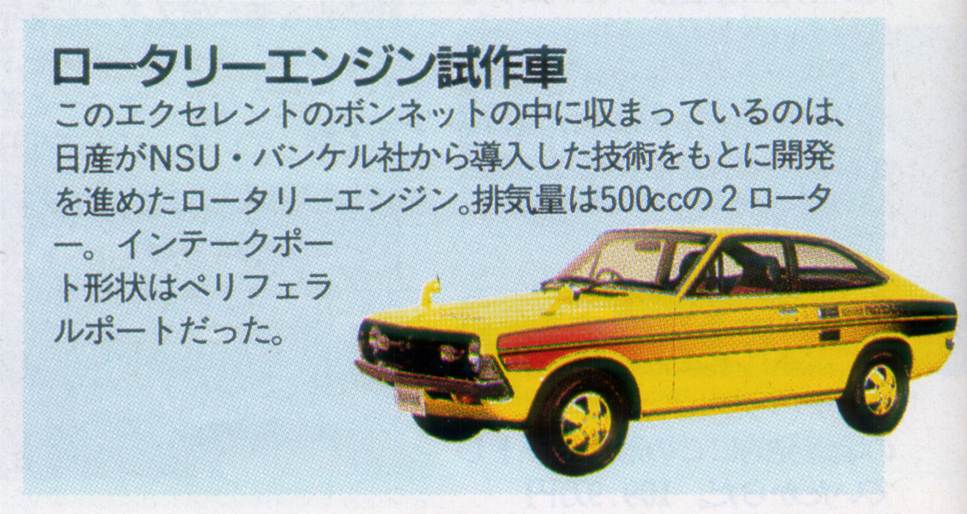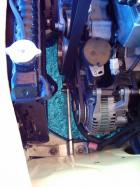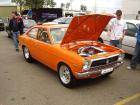Nissan Rotary Power! Whether a factory Nissan rotary engine, or a Mazda rota stuff into a Datsun 1200, excitement is sure to result.
Contents |
Nissan's Own Rotary Engine
At the Tokyo Motor Show, October 19, 1972, Nissan exhibited a Datsun Sunny PB110 with a prototype Nissan twin-rotor wankel-type rotary engine.
This was during the height of the rotary-power frenzy. Wankel had the patent, and every one licensed it, from GM to Mercedes to Mazda, and also Nissan. Nissan's interest started in mid-1965
Datsun Sunny Rotary Prototype
Here is a picture of the prototype being tested in a Datsun Sunny 1200 (B110) coupe:

1972 October: 19th Tokyo Motor Show, Sunny Excellents were fitted with the Nissan rotary.
Datsun S10 Sylvia LS Type X
Reportedly Nissan even sold some rotary-powered Sylvias (S10/S11 models) to the public circa 1978, however, this is not confirmed. reference

High Performance—120 Horsepower
The rotary efforts definitely did *not* stop because the rotary was a poor design. Au contraire, it was amazing!
quote:
Using peripheral ports, two plugs per rotor and a four-barrel carby its 120hp raised the top speed of the Datsun 1200 to 175km/h or 40 more than the original 1200cc four-cylinder. Nissan was setting up production facilities with the (announced) intention of producing 3000 rotary vehicles per month with either five-speed manual or three-speed auto.

Driving report: 112mph and still pulling hard ...
Fuel Economy
Note that Rotaries are not more fuel-wasting than other engines of the same power output. But a 120hp rotary does use more fuel than a 69hp A12 engine, as would seem obvious once we think about it. Initially, there were problems with fuel economy, but that problem was solved by 1976.
info

Under the bonnet of this Excellent is the rotary engine used to advance the development of NISSAN's new rotary, which is based on technology from the NSU Wankel corporation. The swept volume displacement is 2 rotors of 500cc each.
End Of the Rotary Era
The wankel design has the benefit of small size, low weight, high power for the size, and smoothness of operation (they routinely rev to 9k rpm). So why did everyone except Mazda and some non-automakers stop making wankel-style rotaries? It appears to be because of a combination of factors (these are my opinions, not necessarily hard facts):
- Perceived value: at first it seemed that the public would demand these engines, so every automaker figured they better get busy and offer one. The president of Mazda commented something like the following: after Mazda and NSU put these high-power engines into hundreds of thousands of subcompact cars, the economy-minded public—which expected smallcar=econobox—eventually realized that the subcompact car they bought had a high-power engine, not the economy engine they expected. Just like sticking a V8 into a small car, it was enough to give the product a bad rep. Then when the 73-74 oil crisis hit, the manufacturers realized the public was no longer demanding 'rotary' engines. Unfair? Yes, but sometimes the bottom drops out of a market. Unless people start demanding rotaries again, which seems improbably given past history, we'll never seem mass-market rotaries again.
- During the economic recession caused by the oil crises, manufacturers tightened their belts. One way to save money was to stop developing new engines and new car models associated with it. During such times of financial crisis, most companies cut back in their R & D.
- The piston engine worked fine (though still not as smooth as a rotary). The wankel only really offers two advantages: low weight and smoothness. For nearly all applications, bean counters can choose a piston engine instead.
- All the auto makers were in fear of the Piston-Engine emissions control problem. Or should I say they were in fear of too-quickly acquiesing to government regulation and demands. Publicly they stated that they feared that developing slightly different controls for rotary engines would be more than they could handle. This didn't really turn out to be a problem, as the Wankel patent-pool shared the technology which solved the problem in 1972. It seems that US automakers were hesitant to admit to government regulatory agencies that any progess could be made in meeting the anti-pollution demands for piston engines. Yet Mazda met those requirements three years ahead of time, and published the fact to the world. Even so that didn't stop other manufacturers from insisting there were unsolvable problems (even though all wankel licensees had access to the solutions).
Since then, Datsun 1200 enthusiasts in every land have fitted the ubiquitous Mazda rotary engine into the lightweight 1200 body. Result: One fast little car.
Oakland Tribune, 16 Nov 1972, page 29

The Sunday Sun, 27 May 1973, page D8

Engine Swaps
See main article: Mazda rotary engine swap
Rotary-Powered Datsun 1200 photo index
Here are some pictures from our club photo album. Click a pic for larger photos, details, and discussion:

![[Datsun 1200 encyclopedia]](/wiki/upload/wiki.png)



















































